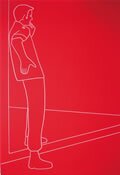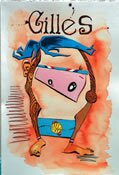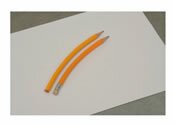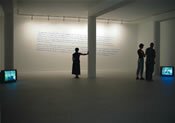Inflight Magazine of Brussels Airlines
Welcome to the Inflight Magazine of Brussels Airlines
Israeli art in the frame
Tel Aviv’s art scene has experienced a renaissance over the past decade, with ever-growing number s of local video artists, photographers and painters making their mark on the international stage.
Dror Sher reports on the city’s rising stars
 Though it might not be the first thing that springs to mind when you think of Israel, the Tel Aviv art scene is really blossoming. Like an injection of fuel into a race car, the fact that every year more Israeli artists are becoming international successes provides a powerful thrust forward for the young art set, to the point where it seems that every week a new gallery emerges and one talked-about exhibition is replaced by another.
Though it might not be the first thing that springs to mind when you think of Israel, the Tel Aviv art scene is really blossoming. Like an injection of fuel into a race car, the fact that every year more Israeli artists are becoming international successes provides a powerful thrust forward for the young art set, to the point where it seems that every week a new gallery emerges and one talked-about exhibition is replaced by another.
This, in part, can be attributed to the huge revolution in Israeli culture during the 1990s. The appearance of commercial and cable TV stations brought the world into every living room in the country, and a dramatic shift from a socialist-style economy to a free-market one was accompanied by a significant change in the local culture market’s view of itself.
In parallel, after the outbreak of the first Intifada in 1987 and the decline of the security situation at that time, there was a backlash against traditional Zionist idealism and a desire to escape the increasingly complicated political realities.
 Sergio Edelstein, director of the Center for Contemporary Art, founded in 1998 to support fresh, young, local talent, attributes the recent successes of Israeli artists to a number of factors. “The expansion of the international art market and its need for new names justifies a greater number of artists,” he says. “Parallel with the tendency of the art market to seek new, interesting artists in places that are more peripheral, a fundamental change took place in the Israeli art world that made it stand out less and be more in tune with what was happening on the world market.”
Sergio Edelstein, director of the Center for Contemporary Art, founded in 1998 to support fresh, young, local talent, attributes the recent successes of Israeli artists to a number of factors. “The expansion of the international art market and its need for new names justifies a greater number of artists,” he says. “Parallel with the tendency of the art market to seek new, interesting artists in places that are more peripheral, a fundamental change took place in the Israeli art world that made it stand out less and be more in tune with what was happening on the world market.”
Multimedia masters
 Two sectors, video art and photography, stand at the forefront of the contemporary Israeli art scene. Although there were hardly any video artists in Israel till the mid-1990s, the field has rapidly become a preferred one for young artists. The absence of an established tradition and the relative simplicity of the technical side have helped. “The development in areas like photography and video art has contributed a great deal to the blending of Israeli artists into the international market,” says Edelstein. “Work in these areas, which by its nature relates to the world of reality, has brought about great interest in the world for Israeli art, mainly because it depicts a society that is in the centre of the political stage.”
Two sectors, video art and photography, stand at the forefront of the contemporary Israeli art scene. Although there were hardly any video artists in Israel till the mid-1990s, the field has rapidly become a preferred one for young artists. The absence of an established tradition and the relative simplicity of the technical side have helped. “The development in areas like photography and video art has contributed a great deal to the blending of Israeli artists into the international market,” says Edelstein. “Work in these areas, which by its nature relates to the world of reality, has brought about great interest in the world for Israeli art, mainly because it depicts a society that is in the centre of the political stage.”
Guy Ben-Ner’s video works have transformed him into one of the most important local ‘export artists’ and gained him a place as Israeli representative to the 2005 Venice Biennale. Ben-Ner deals with masculinity; his works are all shot in and around the home, with the artist himself and his children as actors.
Another prominent video artist is Yael Bartana, whose works deal with the ceremoniality of Israeli society and provide an anthropological view of it.
 In photography, the two most prominent names are Adi Nes, whose carefully staged photos link Jewish and Christian religious tradition with subjects like soldiers and the homeless, and Sharon Ya’ari, who deals mainly with Israeli scenery. “In the last two decades, the biggest Israeli exports were news-related images of blood and murder from the Palestinian territories,” contends Doron Rabina, a successful international artist. “The ability of young art to look ironically at those things and to be less self-justifying, and the ability not to act as an ambassador, is what makes it compelling to me.”
In photography, the two most prominent names are Adi Nes, whose carefully staged photos link Jewish and Christian religious tradition with subjects like soldiers and the homeless, and Sharon Ya’ari, who deals mainly with Israeli scenery. “In the last two decades, the biggest Israeli exports were news-related images of blood and murder from the Palestinian territories,” contends Doron Rabina, a successful international artist. “The ability of young art to look ironically at those things and to be less self-justifying, and the ability not to act as an ambassador, is what makes it compelling to me.”
But you can’t ignore Israeli painting. The paintings and coloured pencil drawings of Eli Petel, winner of the Tel Aviv Museum’s Young Artist Prize for 2007, concentrate on contemporary themes. Petel draws images from television and the news to create an Israeli iconography, accompanied by an ironic wink. Galia Yahav, an important curator, says that local art is in the stage of “powerful rule of the image”, where it examines the image more than the medium or the technique.
 |
 |
Hanging out
 A good place to begin investigating the Israeli art scene is Edelstein’s Center for Contemporary Art (5 Kalisher, 1). Specialising in video art, during 2007 the centre has hosted comprehensive shows by Guy Ben-Ner and Doron Solomons (Brussels Airlines’ co-sponsored ‘Artist in Residence’ at Ypres’ ‘In Flanders Fields WW1 museum), and a retrospective of the works of Boaz Arad. Arad deals mainly with an interplay of the European Ashkenazi with Middle Eastern Mizrachi Jewish societies, alongside an entertaining obsession with the image of Hitler. It’s also possible to spend many hours at the centre’s comprehensive video archive.
A good place to begin investigating the Israeli art scene is Edelstein’s Center for Contemporary Art (5 Kalisher, 1). Specialising in video art, during 2007 the centre has hosted comprehensive shows by Guy Ben-Ner and Doron Solomons (Brussels Airlines’ co-sponsored ‘Artist in Residence’ at Ypres’ ‘In Flanders Fields WW1 museum), and a retrospective of the works of Boaz Arad. Arad deals mainly with an interplay of the European Ashkenazi with Middle Eastern Mizrachi Jewish societies, alongside an entertaining obsession with the image of Hitler. It’s also possible to spend many hours at the centre’s comprehensive video archive.
Many of the city’s veteran – and important – galleries are situated on or around Gordon Street in the uptown city centre. The Rosenfeld Gallery (147 Dizengoff Street, 4) concentrates on polished, and sometimes kinky, contemporary art. Admirers of Matthew Barney will find something of his approach in the popular aesthetics of Zoya Cherkassy, and in Roee Rosen, who focuses on Judaism, Nazism and pornography together with references to history and art theory.
Givon Gallery (35 Gordon, 7) is home to many celebrities of Israeli art, most prominently Adam Rabinowitz and Gil Marco Shani, whose simple drawings, as well as his innovative installation works, have made him one of the biggest stars in the Israeli art world. If you’re in the area, it’s worth hopping over to the Dvir Gallery (11 Nahum, 3), which is considered one of the highest quality and most beautiful spaces in town. Dvir’s trademark is a more intellectual approach, and it’s particularly worthwhile to stop by if there’s a group exhibition, for which the gallery is especially known.
Another gallery quarter has begun to develop at the other end of the city centre, on and near Rothschild Blvd. The most prominent place in this area is the Sommer Contemporary Art Gallery (13 Rothschild, 0), home to big stars such as Yael Bartana, Sharon Ya’ari and Adi Nes. At the Noga (60 Ahad Ha’am St, 3) and Braverman (81 Yehuda Halevi, 2) you’ll find many fresh, talked-about local art school grads. Not far away, near the Tel Aviv Art Museum, is the Alon Segev Gallery (23 Shaul Hamelech Blvd, 9), focusing on contemporary realistic and figurative painting. It represents Nir Hod, the star painter of the late 1990s.
The Israeli contemporary art scene is dynamic, and surely has not reached its full potential. But what does the future hold? “This place is so vibrant and alive that one can never know which direction things will be heading,” says Rabina. “We live in a country that investigates itself all the time, a country that is never content. That describes its art scene as well. In the last decade, this place has produced some fascinating dynamic art. I see no reason why it should stop now.”
FR Le nouveau cadre de l’art israélien
Ce n’est sans doute pas la première chose qui vient à l’esprit lorsqu’on évoque Israël, et cependant la scène artistique à Tel Aviv est en plein développement. On peut attribuer cela en partie à la grande révolution qui s’est opérée dans le monde de la culture israélienne durant les années 1990. Sergio Edelstein, directeur du Centre d’Art Contemporain, explique: “Un changement fondamental est intervenu dans le monde artistique en Israël, qui nous a propulsés à l’avant-plan, et nous a rapprochés de la réalité actuelle des marchés internationaux.”
Maîtres du Multi-media
Les deux secteurs du vidéo-art et de la photographie se démarquent sur cette scène contemporaine. Les travaux vidéo de Guy Ben-Ner en font l’un des artistes locaux les plus importants et les plus “exportables”. Yael Bartana figure au rang des autres artistes vidéo en vue, avec un travail qui questionne les relations complexes de la société israélienne au cérémoniel.
Dans le domaine de la photographie, deux noms s’imposent: Adi Nes et Sharon Ya’ari. Dans ce paysage, la peinture n’est pas en reste. Les peintures et les dessins d’Eli Petel, lauréat du Prix de la Jeune Peinture en 2007 du Musée de Tel Aviv, se concentrent aussi sur des thèmes contemporains.
A la découverte
Un bon endroit d’où démarrer l’exploration de la scène artistique contemporaine en Israël est le Centre d’Art Contemporain Edelstein. La majorité des grandes galeries de la ville sont localisées sur Gordon Street et les rues avoisinantes. La galerie Rosenfeld propose des pièces au côté voyant et parfois extravagant. Un nouveau quartier des galeries a également commencé à émerger sur le Blvd. Rothschild et aux alentours. Dans ce lieu qui perce, on mentionnera la Sommer Contemporary Art Gallery.
La scène contemporaine en Israël montre un dynamisme sans précédent, et c’est certain, elle est loin d’avoir atteint son apogée.
NL Israëlische kunst in de kijker
Je zou het misschien niet verwachten van Israël, maar kunst is hot in Tel Aviv. Dat is deels dankzij de enorme evolutie die de Israëlische cultuur in de jaren ‘90 doormaakte. Sergio Edelstein, directeur van het Centrum voor hedendaagse kunst, licht toe: “De Israëlische kunstsector veranderde ingrijpend. Ze werd minder ‘apart’ en vond meer aansluiting bij internationale tendensen.”
Multimedia
De hedendaagse kunstwereld in Israël is vooral in de ban van videokunst en fotografie. Guy Ben-Ner is met zijn videowerk een van de belangrijkste lokale “exportartiesten” geworden. Nog een prominent videoartiest is Yael Bartana, wiens werk handelt over het ceremoniële aspect van de Israëlische samenleving.
In de fotografie zijn Adi Nes en Sharon Ya’ari de twee grootste namen. En dan is er nog de Israëlische schilderkunst. De schilderijen en tekeningen van Eli Petel, winnaar van de Tel Aviv Museum Young Artist Prize voor 2007, gaan over hedendaagse thema’s.
Op verkenning
Wie wil kennismaken met Israëlische kunst, trekt het best naar Edelsteins Centrum voor hedendaagse kunst. Veel van Tel Avivs belangrijke kunstgalerijen liggen in of rond Gordon Street, in het stadscentrum. De Rosenfeld Gallery herbergt vooral verfijnde, en soms ook excentrieke, hedendaagse kunst. In en rond Rothschild Blvd ontstaat een andere galerijwijk. Het meest prominente adres in deze buurt is de Sommer Contemporary Art Gallery.
De Israëlische hedendaagse kunstwereld is bijzonder dynamisch en heeft zijn volle potentieel nog lang niet bereikt!
Leave a Reply
